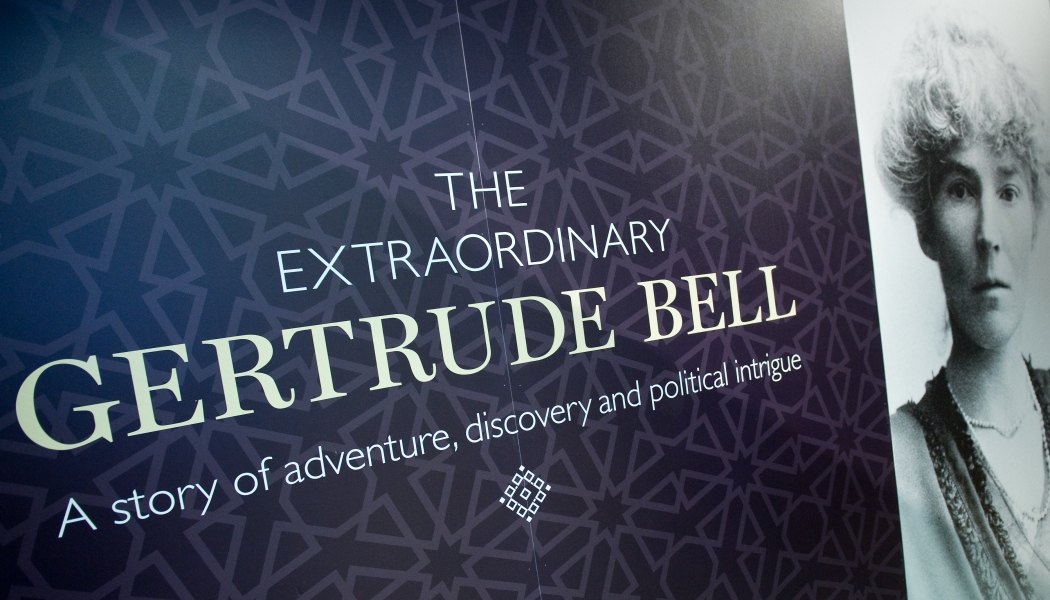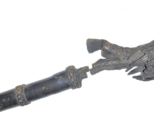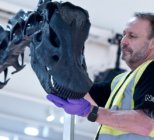Why did you choose Gertrude Bell to star in an exhibition at the Great North Museum: Hancock?
There are many reasons why we chose Gertrude Bell as the focus of our exhibition. Her roots are in the North East and we thought that the local angle was particularly strong. Many places in the region, such as Redcar, where she was brought up and Wallington Hall where her half-sister Mary lived, have strong associations with her. In addition her archive, which includes her letters, diaries and over 7,000 photographs, belongs to Newcastle University at the Gertrude Bell Archive. In effect we had amazing resources on our doorstep with which we could tell her story. Coupled with this we had the support of several academics in Newcastle University who have been using the archive to support their research. This meant that there were great opportunities to work in collaboration with the University on the exhibition and incorporate the very latest research on Gertrude Bell. Finally, and perhaps most importantly, she is an extraordinary individual whose contribution to the Middle East has been overlooked. We wanted to bring this slightly neglected
How have you made Bell’s story come to life in the exhibitions interpretation and design?
The exhibition focuses on Bell’s remarkable archive of letters, diaries and photographs. Her photographs take pride of place. She was a talented photographer and her images shed light on where she travelled, her archaeological research, who she met and some of the key developments in the Middle East during her lifetime. The photographs are supported by extensive use of quotes from her letters, as we felt it was important for her own voice to emerge in the exhibition. Alongside the photographs and quotes the exhibition features objects that relate to her life and times as well as a series of specially commissioned films featuring researchers who are interested in different facets of Gertrude Bell’s career.
The exhibition is organised into key themes from different parts of her life, including her involvement in British campaigns in the Middle East in World War I, her involvement in the creation of the state of Iraq and her work as an archaeologist. The overall design has a strong Middle Eastern feel reflecting her passion for the Arab world and its peoples.
What unique objects and facts will the exhibition share with visitors?
The exhibition has a number of important objects on display. These include some personal items, for example, an engraved silver cigarette case and a gold ring that she purchased in Cairo in 1921 and subsequently gave to her niece Pauline. We also have material from British campaigns against the Ottoman Turks during World War I. Amongst these is a headdress, on loan from the Royal Geographical Society that was worn by Lawrence of Arabia. In terms of her archaeological work we have original notebooks and artefacts that she collected. Alongside these are a series of plaster casts on loan from the British Museum that, as far as we are aware, have never been displayed before. Gertrude Bell made them to record a series of ancient hieroglyphic inscriptions she discovered in Turkey.
The exhibition intends to present a more rounded view of Gertrude Bell than many existing biographies. She is often perceived of as an imposing and quite distant individual who was comfortable in the male dominated worlds of politics, archaeology and exploration. However, the more personal side of her character is revealed in her letters. Her deep affection and respect for her father, Hugh, comes across in these. Moreover some of the letters reveal her complex personal relationships including her profound love for Charles Doughty-Wylie, a British officer killed at Gallipoli during World War I. A more human Gertrude Bell emerges from the letters and hopefully the exhibition expresses this.
What educational programmes have you set up to coincide with the exhibition?
The exhibition is aimed at an adult audience and the educational programmes reflect this. A series of lectures by specialists is programmed to provide additional background on her career. Gallery tours are also planned so that curatorial staff can show visitors around the exhibition and talk in more detail about the display.
How can Bell’s story inspire young and old today?
Gertrude Bell was an extremely strong-willed person who approached the many challenges she faced with courage and determination. This is incredibly inspiring, particularly as she was a woman operating in a world where men were dominant. She never let the fact that she was a woman hold her back. She was the intellectual superior of many of her male colleagues and became someone whose opinions they respected. She was a complex individual who, in certain respects, is hard to understand from a 21st Century perspective, but her drive and steely determination shine through.
What would she make of what is happening in Iraq and the Middle East today?
Gertrude Bell would be heartbroken. There is no argument that she was an imperialist and first and foremost represented the interests of the British Empire but, at the same time, she had a deep love and respect for the Arab peoples and came to see Iraq as her home. The current fragmentation of Iraq would have distressed her as would the suffering of the Iraqi peoples. She was also passionate about the archaeology of Iraq and wrote the country’s first antiquities law as well as founding the National Museum in Baghdad. The current looting and destruction of the region’s archaeological heritage would have appalled her.
What will be the legacy of this exhibition?
We are hopeful that the exhibition will lead to a greater awareness of the importance of Gertrude Bell in terms of her impact on the Middle East as an archaeologist, explorer and diplomat. She is frequently overshadowed by her contemporary, Lawrence of Arabia, but arguably she had a more significant role in shaping the Middle East after World War I and this is something we would like to bring to the fore. Another positive outcome will be increased awareness of the Gertrude Bell archive held by Newcastle University. This is an amazing resource for understanding both her life and the Middle East in the early 20th Century.
A variant of the exhibition is going to Kirkleatham Museum in Redcar once it finishes it run at the Great North Museum and this will extend its reach to a town that was her childhood home. Furthermore there is a book published to complement the exhibition that contains a series of short essays on Gertrude Bell and this is another way in which the exhibition will have a legacy. Working on this exhibition has brought a lot of people interested in Gertrude Bell together and we are hopeful that it will stimulate plenty of future collaborations on her life and work.











